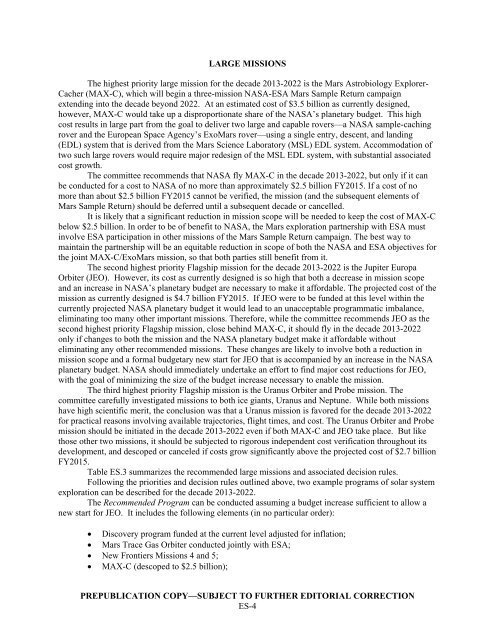Vision and Voyages for Planetary Science in the - Solar System ...
Vision and Voyages for Planetary Science in the - Solar System ...
Vision and Voyages for Planetary Science in the - Solar System ...
Create successful ePaper yourself
Turn your PDF publications into a flip-book with our unique Google optimized e-Paper software.
LARGE MISSIONS<br />
The highest priority large mission <strong>for</strong> <strong>the</strong> decade 2013-2022 is <strong>the</strong> Mars Astrobiology Explorer-<br />
Cacher (MAX-C), which will beg<strong>in</strong> a three-mission NASA-ESA Mars Sample Return campaign<br />
extend<strong>in</strong>g <strong>in</strong>to <strong>the</strong> decade beyond 2022. At an estimated cost of $3.5 billion as currently designed,<br />
however, MAX-C would take up a disproportionate share of <strong>the</strong> NASA’s planetary budget. This high<br />
cost results <strong>in</strong> large part from <strong>the</strong> goal to deliver two large <strong>and</strong> capable rovers—a NASA sample-cach<strong>in</strong>g<br />
rover <strong>and</strong> <strong>the</strong> European Space Agency’s ExoMars rover—us<strong>in</strong>g a s<strong>in</strong>gle entry, descent, <strong>and</strong> l<strong>and</strong><strong>in</strong>g<br />
(EDL) system that is derived from <strong>the</strong> Mars <strong>Science</strong> Laboratory (MSL) EDL system. Accommodation of<br />
two such large rovers would require major redesign of <strong>the</strong> MSL EDL system, with substantial associated<br />
cost growth.<br />
The committee recommends that NASA fly MAX-C <strong>in</strong> <strong>the</strong> decade 2013-2022, but only if it can<br />
be conducted <strong>for</strong> a cost to NASA of no more than approximately $2.5 billion FY2015. If a cost of no<br />
more than about $2.5 billion FY2015 cannot be verified, <strong>the</strong> mission (<strong>and</strong> <strong>the</strong> subsequent elements of<br />
Mars Sample Return) should be deferred until a subsequent decade or cancelled.<br />
It is likely that a significant reduction <strong>in</strong> mission scope will be needed to keep <strong>the</strong> cost of MAX-C<br />
below $2.5 billion. In order to be of benefit to NASA, <strong>the</strong> Mars exploration partnership with ESA must<br />
<strong>in</strong>volve ESA participation <strong>in</strong> o<strong>the</strong>r missions of <strong>the</strong> Mars Sample Return campaign. The best way to<br />
ma<strong>in</strong>ta<strong>in</strong> <strong>the</strong> partnership will be an equitable reduction <strong>in</strong> scope of both <strong>the</strong> NASA <strong>and</strong> ESA objectives <strong>for</strong><br />
<strong>the</strong> jo<strong>in</strong>t MAX-C/ExoMars mission, so that both parties still benefit from it.<br />
The second highest priority Flagship mission <strong>for</strong> <strong>the</strong> decade 2013-2022 is <strong>the</strong> Jupiter Europa<br />
Orbiter (JEO). However, its cost as currently designed is so high that both a decrease <strong>in</strong> mission scope<br />
<strong>and</strong> an <strong>in</strong>crease <strong>in</strong> NASA’s planetary budget are necessary to make it af<strong>for</strong>dable. The projected cost of <strong>the</strong><br />
mission as currently designed is $4.7 billion FY2015. If JEO were to be funded at this level with<strong>in</strong> <strong>the</strong><br />
currently projected NASA planetary budget it would lead to an unacceptable programmatic imbalance,<br />
elim<strong>in</strong>at<strong>in</strong>g too many o<strong>the</strong>r important missions. There<strong>for</strong>e, while <strong>the</strong> committee recommends JEO as <strong>the</strong><br />
second highest priority Flagship mission, close beh<strong>in</strong>d MAX-C, it should fly <strong>in</strong> <strong>the</strong> decade 2013-2022<br />
only if changes to both <strong>the</strong> mission <strong>and</strong> <strong>the</strong> NASA planetary budget make it af<strong>for</strong>dable without<br />
elim<strong>in</strong>at<strong>in</strong>g any o<strong>the</strong>r recommended missions. These changes are likely to <strong>in</strong>volve both a reduction <strong>in</strong><br />
mission scope <strong>and</strong> a <strong>for</strong>mal budgetary new start <strong>for</strong> JEO that is accompanied by an <strong>in</strong>crease <strong>in</strong> <strong>the</strong> NASA<br />
planetary budget. NASA should immediately undertake an ef<strong>for</strong>t to f<strong>in</strong>d major cost reductions <strong>for</strong> JEO,<br />
with <strong>the</strong> goal of m<strong>in</strong>imiz<strong>in</strong>g <strong>the</strong> size of <strong>the</strong> budget <strong>in</strong>crease necessary to enable <strong>the</strong> mission.<br />
The third highest priority Flagship mission is <strong>the</strong> Uranus Orbiter <strong>and</strong> Probe mission. The<br />
committee carefully <strong>in</strong>vestigated missions to both ice giants, Uranus <strong>and</strong> Neptune. While both missions<br />
have high scientific merit, <strong>the</strong> conclusion was that a Uranus mission is favored <strong>for</strong> <strong>the</strong> decade 2013-2022<br />
<strong>for</strong> practical reasons <strong>in</strong>volv<strong>in</strong>g available trajectories, flight times, <strong>and</strong> cost. The Uranus Orbiter <strong>and</strong> Probe<br />
mission should be <strong>in</strong>itiated <strong>in</strong> <strong>the</strong> decade 2013-2022 even if both MAX-C <strong>and</strong> JEO take place. But like<br />
those o<strong>the</strong>r two missions, it should be subjected to rigorous <strong>in</strong>dependent cost verification throughout its<br />
development, <strong>and</strong> descoped or canceled if costs grow significantly above <strong>the</strong> projected cost of $2.7 billion<br />
FY2015.<br />
Table ES.3 summarizes <strong>the</strong> recommended large missions <strong>and</strong> associated decision rules.<br />
Follow<strong>in</strong>g <strong>the</strong> priorities <strong>and</strong> decision rules outl<strong>in</strong>ed above, two example programs of solar system<br />
exploration can be described <strong>for</strong> <strong>the</strong> decade 2013-2022.<br />
The Recommended Program can be conducted assum<strong>in</strong>g a budget <strong>in</strong>crease sufficient to allow a<br />
new start <strong>for</strong> JEO. It <strong>in</strong>cludes <strong>the</strong> follow<strong>in</strong>g elements (<strong>in</strong> no particular order):<br />
• Discovery program funded at <strong>the</strong> current level adjusted <strong>for</strong> <strong>in</strong>flation;<br />
• Mars Trace Gas Orbiter conducted jo<strong>in</strong>tly with ESA;<br />
• New Frontiers Missions 4 <strong>and</strong> 5;<br />
• MAX-C (descoped to $2.5 billion);<br />
PREPUBLICATION COPY—SUBJECT TO FURTHER EDITORIAL CORRECTION<br />
ES-4











